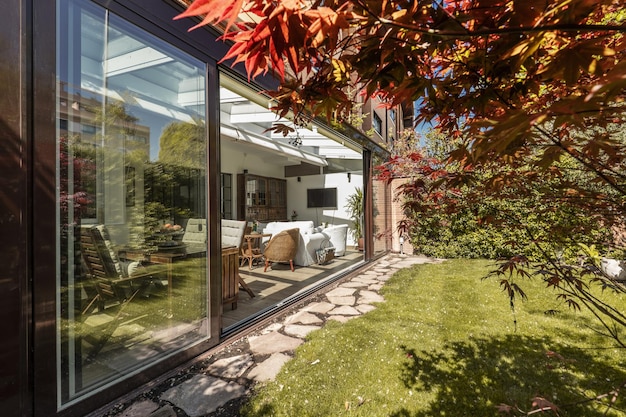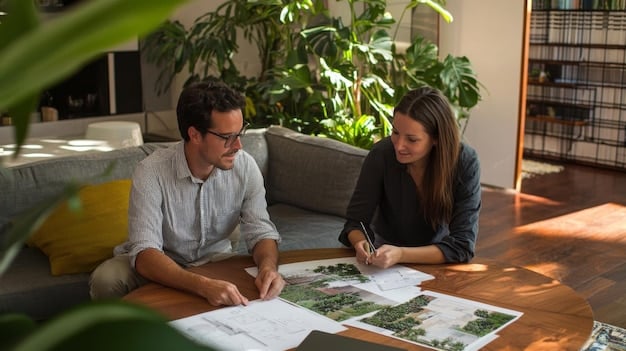Garden Room Construction: Planning Permission Rules Updated for 2025

Anúncios
Navigating the updated planning permission rules for garden room construction in the UK for 2025 ensures your project complies with regulations, avoids legal issues, and enhances your property seamlessly.
Dreaming of a garden room? The landscape of Garden Room Construction: Planning Permission Rules Updated for 2025 is essential knowledge, guiding you through the latest regulations to ensure your project proceeds smoothly and legally.
Anúncios
Understanding Garden Room Planning Permission in the UK
Understanding the nuances of planning permission is crucial before embarking on any garden room construction project. In the UK, regulations are in place to ensure development aligns with local planning policies and doesn’t negatively impact the surrounding environment or neighbouring properties.
Familiarising yourself with these rules can save you time, money, and potential legal complications down the line.
Anúncios
The Basics of Planning Permission
Planning permission is generally required for building projects that involve significant changes to your property, such as extending the building, altering its appearance, or changing its use. However, many smaller projects, including some garden rooms, can be carried out under permitted development rights.
These rights allow for certain types of development without the need for a full planning application, provided specific limits and conditions are met.
Permitted Development Rights for Garden Rooms
Permitted development rights are a valuable asset for homeowners looking to add a garden room without navigating the full planning permission process. However, it’s essential to understand the limitations and conditions that apply.
- Size Restrictions: The garden room must not exceed certain height and size limits, which vary depending on the type of property and its location.
- Location: The positioning of the garden room within your property is crucial. It must not be located forward of the principal elevation or, in certain cases, closer to any boundary.
- Use: The intended use of the garden room must be incidental to the enjoyment of the main dwelling house.
- Materials: The materials used in construction should be in keeping with the existing property and the surrounding area.
Navigating these regulations requires care and attention to detail, but can lead to a smoother and more cost-effective garden room construction.
Understanding planning permission requirements is an essential first step for any garden room project. You can ensure that your project meets all the guidelines by thoroughly researching and potentially consulting with local planning experts.
Key Changes to Planning Permission Rules for 2025
The world of planning regulations is subject to change as the government strives to address new challenges and adopt updated policies. For the year 2025, several noteworthy changes to planning permission rules are slated to impact garden room construction projects.
Keeping abreast of these changes will help ensure that your garden room project is compliant, future-proof, and respectful of evolving UK legislation.
Updated Guidelines on Garden Room Size and Height
One of the prominent adjustments for 2025 centres around the permissible size and height specifications for garden rooms operating under permitted development rights. The revised guidelines take a more granular approach to size calculations, considering the overall footprint of existing buildings on the property.
This means that the available space for your garden room may be less than previously assumed.
New Regulations Regarding Proximity to Boundaries
Another significant alteration involves the regulations surrounding the distance between the garden room and the property boundaries. In 2025, stricter measures will be applied to constructions near boundaries, particularly in areas designated as conservation zones or Areas of Outstanding Natural Beauty.

The implications for garden room design are potentially far-reaching, necessitating adjustments to size and location to ensure compliance.
Impact of Environmental Considerations on Planning
As environmental consciousness grows, so too does the importance of sustainable building practices in planning regulations. The 2025 updates place increased emphasis on sustainable materials, energy efficiency, and the overall ecological impact of garden room construction.
- Sustainable Materials: Using recycled or sustainably sourced materials is highly encouraged.
- Energy Efficiency: Designs that incorporate energy-efficient technologies, such as solar panels or improved insulation, may be favoured.
- Ecological Impact: Consideration of the impact on local biodiversity and green spaces is now a critical factor in the planning process.
By prioritising sustainable practices, not only will you align with the updated planning guidelines, but you’ll also contribute to a more environmentally friendly future.
Staying informed about these key changes is crucial for successfully navigating the planning permission landscape. Consulting with local planning experts can give you tailored advice that considers your specific property and location.
Strategies for Ensuring Planning Permission Compliance
Ensuring your garden room project aligns with planning permission regulations doesn’t have to be daunting. By adopting a proactive approach and employing effective strategies, you can navigate the process with confidence and minimise the risk of delays or legal issues.
Here are some strategies that can help you achieve planning permission compliance.
Comprehensive Site Assessment
The cornerstone of planning permission compliance is a comprehensive site assessment. This involves a thorough evaluation of your property’s dimensions, features, and surrounding environment to identify any potential constraints or considerations that could impact your garden room design.
Factors to consider include boundary lines, existing structures, protected trees, and any relevant conservation area designations.
Engaging with Local Planning Authorities
Establishing open communication with your local planning authority can be invaluable in navigating the complexities of planning permission. Consult with planning officers to discuss your proposed project, seek guidance on relevant regulations, and address any potential concerns proactively.

This collaborative approach can help streamline the planning process and increase the likelihood of a successful outcome.
Professional Architectural Design
Investing in a professional architectural design can significantly enhance your chances of planning permission compliance. Architects possess the technical expertise to create designs that adhere to building regulations, maximise permitted development rights, and address any site-specific challenges.
- Maximising Permitted Development: Architects can optimise your design to fit within the scope of permitted development rights.
- Compliance with Building Regulations: They can ensure your project meets all necessary building regulations.
- Addressing Site-Specific Challenges: Architects can provide innovative solutions to overcome site-specific constraints.
A well-crafted design can not only ensure compliance but also enhance the aesthetic appeal and functionality of your garden room.
By embracing these strategies, you can approach your garden room project with confidence, knowing that you’ve taken the necessary steps to ensure planning permission compliance. This proactive approach can save you time, money, and potential headaches down the line.
The Role of Building Regulations in Garden Room Construction
While planning permission focuses primarily on the external appearance and impact of a building project, building regulations are concerned with the structural integrity, safety, and energy efficiency of the construction itself. For garden rooms, adherence to building regulations is just as critical as obtaining planning permission.
Understanding the requirements and ensuring compliance can protect your investment and the safety of those who use the space.
Key Aspects of Building Regulations
Building regulations cover a wide range of aspects related to construction, including structural stability, fire safety, ventilation, insulation, and electrical and plumbing installations.
Garden rooms, even those built under permitted development rights, must comply with these regulations to ensure they are safe and habitable.
How Building Regulations Apply to Garden Rooms
The specific building regulations that apply to your garden room will depend on factors such as its size, intended use, and proximity to the main dwelling. For example, if the garden room includes sleeping accommodation or kitchen facilities, more stringent requirements may apply.
- Structural Stability: The garden room must be structurally sound and able to withstand environmental loads.
- Fire Safety: Adequate fire protection measures must be in place, including fire-resistant materials and escape routes.
- Ventilation: The garden room must have sufficient ventilation to prevent moisture build-up and maintain air quality.
- Insulation: The garden room must be adequately insulated to conserve energy and maintain a comfortable temperature.
Engaging with a qualified building control body can help you understand the specific requirements that apply to your project.
Navigating the Building Regulations Process
There are two main routes for demonstrating compliance with building regulations: submitting a building notice or making a full plans application. A building notice is a simplified process suitable for straightforward projects, while a full plans application involves submitting detailed plans and specifications for approval before work begins.
Consulting with a building control surveyor can help you decide which route is best suited to your project.
By understanding the role of building regulations and taking the necessary steps to ensure compliance, you can create a garden room that is not only aesthetically pleasing but also safe, durable, and environmentally responsible.
Common Misconceptions about Garden Room Planning Permission
The topic of garden room planning permission is often shrouded in misconceptions and misunderstandings, leading homeowners to make incorrect assumptions that can lead to undesirable outcomes. Let’s dispel some of the most common misconceptions surrounding planning permission.
Clarifying these misconceptions can streamline your project and minimise potential issues.
“Permitted Development Means No Regulations Apply”
One of the most pervasive misconceptions is that permitted development rights grant carte blanche to build whatever you want. While permitted development does allow for certain projects without a full planning application, it is subject to specific limitations and conditions.
These include restrictions on size, height, location, and use.
“Planning Permission is Only Needed for Large Garden Rooms”
Another common misconception is that only large garden rooms require planning permission. The size of your garden room is certainly a factor, but other considerations, such as proximity to boundaries, location on the property, and intended use, can also trigger the need for planning permission.
Even a small garden room may require planning permission if it falls outside the scope of permitted development rights.
“Neighbour Objections Always Stop a Project”
While neighbour objections can complicate the planning permission process, they do not automatically halt a project. Planning authorities will carefully consider any objections raised, but they will also weigh them against relevant planning policies and the overall merits of the proposal.
- Planning policies: Objections must be aligned with local planning policies to be considered.
- Overall merits: The planning authority will consider the community benefit alongside neighbour objections.
Addressing any concerns raised by neighbours proactively can increase the chances of a favourable outcome.
“Ignoring Planning Rules is Harmless”
Perhaps the most dangerous misconception is that ignoring planning rules is harmless. Building a garden room without the necessary planning permission or building regulations approval can have serious consequences, including enforcement action from the local authority.
This can result in fines, legal proceedings, or even the demolition of the structure.
By dispelling these common misconceptions, you can approach your garden room project with a clear understanding of the planning permission landscape and avoid potentially costly mistakes. Always seek professional advice to ensure compliance with all relevant regulations.
Future Trends in Garden Room Planning and Construction
As we look ahead to the future, several trends are poised to shape the landscape of garden room planning and construction. These trends are driven by evolving consumer preferences, technological advancements, and a growing focus on sustainability.
Understanding these trends can help you make informed decisions about your garden room project and ensure that it remains relevant and valuable for years to come.
Increased Focus on Sustainability
Sustainability will continue to be a driving force in the future of garden room construction. Homeowners are increasingly seeking eco-friendly materials, energy-efficient designs, and construction methods that minimise environmental impact. Future garden rooms will likely incorporate features such as solar panels, rainwater harvesting systems, and green roofs.
The emphasis will be on creating spaces that are not only aesthetically pleasing but also environmentally responsible.
Integration of Smart Technology
Smart technology is set to play a significant role in the future of garden rooms. Automated lighting, temperature control, and security systems are becoming increasingly common, allowing homeowners to control their garden room environment remotely and enhance its functionality.
Voice-activated assistants and internet-connected devices will further streamline the user experience.
Modular and Prefabricated Construction
Modular and prefabricated construction methods are gaining popularity due to their speed, efficiency, and cost-effectiveness. These methods involve constructing garden room components off-site and then assembling them on the property. This can significantly reduce construction time and minimise disruption to the homeowner.
Modular designs also offer greater flexibility and customisation options.
Greater Emphasis on Biophilic Design
Biophilic design, which seeks to connect people with nature, is becoming increasingly prevalent in garden room construction. This involves incorporating natural materials, maximising natural light, and incorporating plants and greenery into the design.
The goal is to create spaces that promote well-being and enhance the connection with the surrounding environment.
By embracing these future trends, you can create a garden room that is not only functional and aesthetically pleasing but also sustainable, technologically advanced, and aligned with evolving consumer preferences. This will ensure that your garden room remains a valuable asset for years to come.
| Key Point | Brief Description |
|---|---|
| 🏡 Permitted Development | Allows construction without full planning permission if guidelines are met. |
| 📏 Size & Height Rules | Restrictions on garden room size and height are updated for 2025, considering the total footprint of existing constructions. |
| 🌳 Eco-Friendly Materials | Emphasis on recyclable and renewable construction materials for environmental sustainability. |
| 🤝 Consult Authorities | Communicate with authorities early to clear up any doubts. |
FAQ Section
▼
Not necessarily, many garden rooms can be built under permitted development rights, provided they meet specific size, height, and location criteria. However, it’s always best to check with your local planning authority.
▼
Key changes include updated guidelines on garden room size and height, stricter regulations regarding proximity to boundaries, and increased emphasis on sustainable materials and construction practices.
▼
The distance requirements vary depending on your location and the height of the garden room. Always consult local codes and regulations for specific guidance as proximity guidelines change often.
▼
Building regulations ensure the structural integrity, energy efficiency, and safety features of the building, covering structural stability, fire safety and appropriate installations. Regulations also ensure adherence to building codes which are legally binding.
▼
Thorough evaluations of existing property details combined with open communication lines with local authorities is the first step! From here a professional architect ensures max compliance, but ultimately, do your research!
Conclusion
Staying up-to-date with Garden Room Construction: Planning Permission Rules Updated for 2025 is essential for a smooth, compliant project. Understanding permitted development rights, size and location rules, sustainability guidelines, and future construction trends helps homeowners navigate the construction world safely and confidently.





